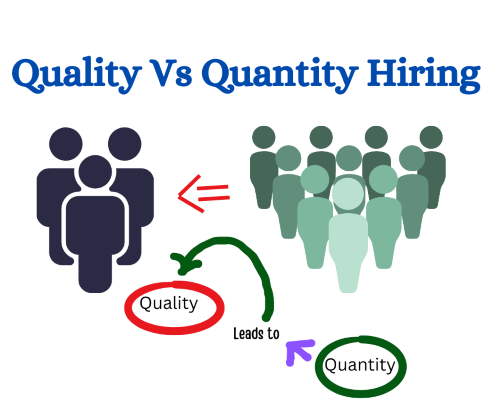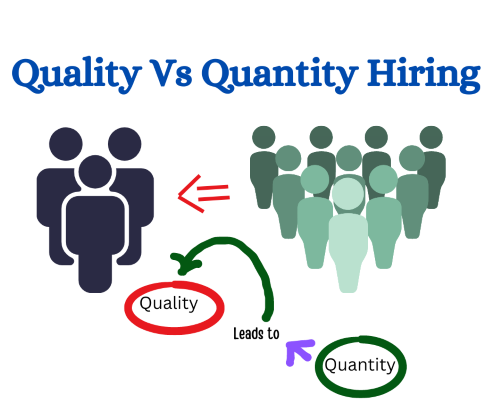
Starategic People Management
Our Latest Articles

03 May2023
Hiring Quality or Quantity – What matters the most?

As every Business progress through the different stages: from start-up to growth to expansion, they share one goal in common, other than earning profitability, that is “to strive for Quality hire”. It is one of the critical factors for the organization to succeed because quality candidates tend to be top performers, they associate with company for long-term and contribute to the bottom line.
Quality of hire, which itself is a very challenging task, constitutes of two important characteristics: Time and Quantity.
Time is crucial factor in the process of making a quality hire. Remember you are not alone in the journey of War for Talent, even your competitors are very much active. One, who is able to spot the right candidate, and present attractive role and compensation in the shortest time period, would win the talent. Whether hiring is for Entry-level, or Middle, or Senior- level, while designing recruitment strategies ensure it also includes how would you tackle the time constraints.


Quantity is integrated with Quality. Quantity gives an opportunity to explore the available talent in the market and helps to strengthen recruitment strategy when used rightly. Merely focusing on quantity hire may lead to higher turnover and increase in cost of hire and have overall negative impact on the growth of organization.
Be extremely cautious to blend quantity and time in right proportion in the strategy, it is the key to gain a competitive advantage over the competitors.
Defining what “quality hire” means to your organization sets the beginning and forms core for developing the recruitment strategy. Once this is clearly defined, then determine the ratio of No of Hires to Quantity of candidates and then considering factors (external or internal) that could you have direct or indirect impact on hiring process, set the maximum time constraint.
For example, let’s say you are hiring for customer service executive at entry level. For this role, Quality hire means patience, listener, communicative and problem-solver. Based on past experience and research, you learnt that 1 out of 10 candidates you met / interviewed exhibit these characteristics. That means, you might need minimum 3 and maximum 5 candidates in the final selection process in order to fill one position. Thus, Quality-Quantity ratio will be 5:50. Similarly, for middle level role, Quality hire definition could vary, and 1 out of 3 candidates you interviewed might exhibit those characteristics. In this case, you may need minimum 3 and maximum 4 candidates in the final selection process in order to fill one position. Thus, Quality-Quantity ratio will be 4:12. Remember to consider the external or internal factors that was mentioned earlier, some of those examples are workplace diversity, place of work, compensation budget, sourcing tool etc. accordingly set the realistic time constraint required to fill each position.
The best recruitment strategy is the one that encompass all the three factors: Quality, Quantity and time. Mastering how to effectively integrate all the three factors in hiring process determines the success of hiring strategy.
Brugu has been gaining extensive knowledge and experience, while it works with many clients in various industry, on hiring quality candidates, presenting the candidates in required quantity within the time constraints. With our experience and expertise, we are able to provide insight and valuable recommendations in the process of designing the better hiring strategy for our clients.

25 Jan2018
MSME: How To Turn Setbacks Into Opportunity And Achieve Growth
Indian government has introduced new policies and strengthened current policies to improve the business environment for MSME. As per Analysis published by KPMG, MSME are contributing 18% and 34% growth respectively in manufacturing and service sector.
Yes, that’s good sign of growth and we cannot deny MSME sector, acknowledged as the backbone of the India economy, contributing significantly to India’s growing GDP. In my view, MSME’s have a greater potential to grow and compete in global market. But where are they failing in utilizing their potential, in spite of having more than a decade experience in their Industry?
On analyzing we found that MSME’s lack focus on major areas, which I would like to split under 3 heads.
Business Operations:
1.Improvisation on the Quality of Service provided to client/customers.
2.Up-gradation on product / services offerings as per the market requirement.
Human Resource Management:
1.Hiring Right Resources / Maximizing the utilization of Existing Resources.
2. Providing necessary training to Employees.
3. Keep up Entrepreneurial spirit and Employee Motivation at high level.
4.Aligning organizational goal with employee’s goal.
Sales & Marketing:
1.Transforming the sales process from traditional approach to Digital approach.
2.Focus on customer behavior i.e. understanding on their need/preferences/presence.
3.Keep abreast on new developments of their Competitors Products/ Services.
I know some of you must be wondering Why is Finance missing in the list?Isn’t that supposed to be on top of the list. According to Economist, first and foremost, major constraint that affect the growth of MSME’s are “Finance/ Funds “
If MSME’s seriously consider focusing on the improving the areas discussed above, I assure funding will no more be a Challenge. Traditional Banks and Venture Capitalist will be optimistic and aggressive to invest in MSME’s. I foresee MSME’s having greater potential to increase their GDP contribution by 25% in next 3-5 years.
In further section, we will get into the detailed analysis under each head. Until then your views / comments will much be appreciated.